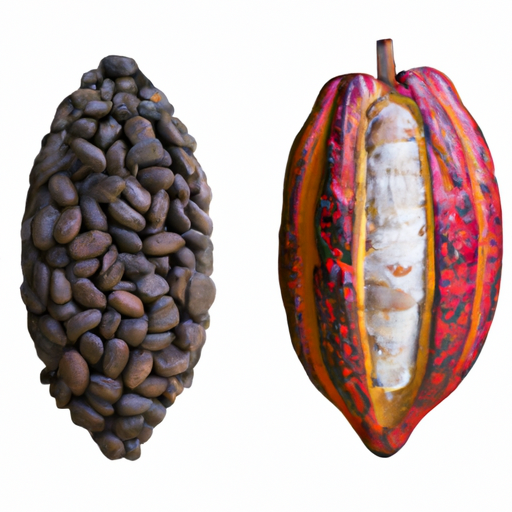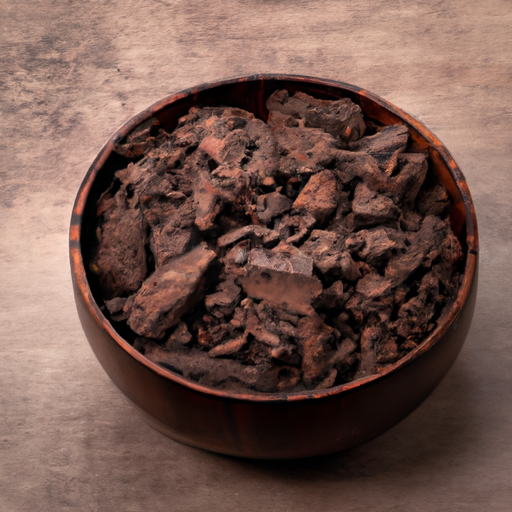When it comes to chocolate, it’s like entering a world filled with luxurious, velvety goodness. Have you ever pondered the dissimilarity between cocoa and raw cacao? Allow me to illuminate this delightful conundrum.
Picture yourself in a chocolate factory, surrounded by the enticing aroma of freshly brewed cocoa and the earthy essence of raw cacao. These two ingredients may seem similar, but they have distinct characteristics.
In this article, we will explore the origins, flavor profiles, nutritional differences, and culinary uses of cocoa and raw cacao. We will also delve into their processing methods and the impact on the environment and society.
By the end, you’ll be equipped with the knowledge needed to make an informed choice about which one to use in your next chocolatey creation. So, let’s dive into the world of cocoa and raw cacao and discover their unique qualities together.
Key Takeaways
- Cocoa is the processed form of the seeds, while raw cacao is made from unroasted, unprocessed seeds.
- Raw cacao has a higher antioxidant content and nutrient density compared to cocoa.
- Cocoa powder is commonly used in baking and making hot chocolate, while raw cacao powder is used in raw desserts and smoothies.
- Both cocoa and raw cacao offer health benefits, including being rich in antioxidants and minerals.
The Origins of Cocoa and Raw Cacao
The origins of cocoa and raw cacao can be traced back to ancient civilizations. Both cocoa and raw cacao come from the seeds of the Theobroma cacao tree.
The flavor origins of cocoa and raw cacao can be attributed to the fermentation and drying processes used to prepare the seeds. Cocoa refers to the processed form of the seeds, while raw cacao is made from unroasted, unprocessed seeds.
The historical significance of cocoa and raw cacao can be seen in their use by ancient civilizations such as the Mayans and Aztecs. These civilizations considered them valuable commodities and even used them as currency. These ancient cultures also believed in the medicinal properties of cocoa and raw cacao.
Transitioning into the subsequent section about ‘flavor profiles’, it is important to understand the differences between cocoa and raw cacao in terms of taste and aroma.
Flavor Profiles
When you taste cocoa, you’ll experience a rich and smooth flavor that dances on your taste buds, while raw cacao offers an intense and vibrant taste that bursts with earthy notes. The flavor profiles of cocoa and raw cacao are distinct, catering to different taste preferences. Cocoa, derived from roasted and ground cacao beans, has a milder and sweeter taste due to the roasting process. On the other hand, raw cacao, made from unroasted cacao beans, retains its natural bitterness and deep chocolate flavor. To provide a visual representation of these flavor profiles, the table below highlights the differences between cocoa and raw cacao:
| Flavor Profiles | Cocoa | Raw Cacao |
|---|---|---|
| Taste | Mild and Sweet | Bitter and Bold |
| Notes | Smooth | Earthy |
Moving on to the subsequent section about nutritional differences, it is interesting to explore how these flavor profiles correlate with the varying nutritional compositions.
Nutritional Differences
Let’s delve into the nutritional contrasts of cocoa and raw cacao and discover how their distinct flavor profiles align with their unique health benefits. When it comes to health benefits, raw cacao takes the lead due to its minimal processing techniques. Here are four key differences in the nutritional profiles of cocoa and raw cacao:
- Raw cacao is packed with antioxidants, which help protect the body against free radicals and reduce inflammation.
- Raw cacao is a good source of magnesium, which is essential for maintaining healthy nerve and muscle function.
On the other hand, cocoa undergoes a higher level of processing, which reduces its antioxidant content and nutrient density. Additionally, cocoa powder often contains added sugars and fats, which can detract from its overall health benefits.
Moving forward, let’s explore how these distinct nutritional profiles translate into their culinary uses.
Culinary Uses
Indulge in the rich and velvety taste of cocoa and raw cacao as you explore their delicious culinary possibilities. Both cocoa and raw cacao can be used in a variety of culinary techniques to enhance the flavor of sweet and savory dishes.
Cocoa powder, which is made by processing roasted cacao beans, is commonly used in baking, making hot chocolate, and as a topping for desserts.
On the other hand, raw cacao powder, which is made from unroasted cacao beans, is often used in raw desserts, smoothies, and as a healthy alternative to cocoa in recipes.
In addition to their culinary uses, both cocoa and raw cacao offer numerous health benefits, including being rich in antioxidants and minerals like magnesium.
Transitioning into the subsequent section about processing methods, it is important to understand how these two ingredients are produced.
Processing Methods
Discover the fascinating ways in which cocoa and raw cacao are transformed through various processing methods to unlock their full potential. The differences in flavor and health benefits between cocoa and raw cacao can be attributed to these processing methods.
| Processing Method | Cocoa | Raw Cacao |
|---|---|---|
| Fermentation | Cocoa beans are fermented for several days, developing complex flavors. | Raw cacao beans are fermented for a shorter period, resulting in a more bitter taste. |
| Roasting | Cocoa beans are roasted at high temperatures to enhance flavors and reduce bitterness. | Raw cacao beans are roasted at lower temperatures, preserving more of their natural nutrients. |
| Grinding | Cocoa beans are ground into a fine powder, creating cocoa. | Raw cacao beans are ground into a paste, which can be used to make raw cacao powder or other products. |
These processing methods significantly influence the final product’s taste and health benefits. The fermentation process gives cocoa its rich, deep flavors, while the shorter fermentation of raw cacao preserves its intense bitterness. Roasting affects the flavor profiles, with cocoa being smoother and less bitter compared to raw cacao. Additionally, the lower roasting temperature of raw cacao retains more antioxidants and nutrients. The grinding process determines the texture and versatility of the end products. Cocoa powder is commonly used in baking, while raw cacao powder is popular in raw desserts and smoothies.
This transformation from cocoa to raw cacao highlights the distinct differences between the two. In the next section, we will explore the availability and accessibility of these products, providing insights into their widespread use and consumption.
Availability and Accessibility
When it comes to the availability of cocoa products, they can be found in most grocery stores and supermarkets, making them easily accessible to consumers.
On the other hand, raw cacao, which is less commonly used, may be more difficult to find in regular stores. However, specialty stores and online options offer a wider range of raw cacao products for those seeking this variation.
Additionally, the cost of cocoa products is generally lower compared to raw cacao, which can be attributed to the processing methods and the demand for each variation in the market.
Common availability of cocoa products
You’ll find a wide array of cocoa products readily available in most grocery stores, allowing you to easily incorporate its rich flavor and health benefits into your daily routine. When it comes to availability, cocoa products are widely distributed and can be found in different regions around the world. These products include cocoa powder, cocoa nibs, and chocolate bars made from cocoa beans. Cocoa products have gained popularity due to their numerous health benefits, including being a rich source of antioxidants and flavonoids, which have been linked to improved heart health and reduced inflammation. In addition, cocoa products are known to boost mood and cognitive function. Transitioning to the subsequent section, specialty stores and online options offer a wider range of raw cacao products for those seeking a more specialized experience.
Specialty stores and online options for raw cacao
Finding raw cacao can be a bit more challenging than cocoa products, but there are specialty stores and online options available. One option is to visit local health food stores or natural food markets, as they often carry a variety of raw cacao products. These specialty stores source their cacao from reputable suppliers who prioritize quality and sustainability.
Another option is to explore online retailers specializing in superfoods and organic products. These retailers often offer a wide range of raw cacao options. However, it’s important to read reviews and check for certifications to ensure the authenticity and purity of the raw cacao products.
In terms of health benefits, raw cacao is known to be rich in antioxidants, minerals, and flavonoids, which can contribute to cardiovascular health and overall well-being.
Transitioning into the next section, it’s essential to consider the cost differences between the two variations.
Cost differences between the two variations
If you’re looking to compare the prices of these two variations, it’s important to consider the cost factors involved. When it comes to cost comparisons between cocoa and raw cacao, there are several factors to take into account. Firstly, the quality differences between the two can greatly affect the price. Raw cacao is generally considered to be of higher quality and is often sourced from specific regions known for their superior cacao beans. This higher quality often comes with a higher price tag. On the other hand, cocoa is more widely available and can be produced on a larger scale, leading to a lower cost. Additionally, the processing methods used for each variation can also impact the cost. Overall, the cost of raw cacao is typically higher than that of cocoa due to its higher quality and more specialized production processes.
| Factor | Cocoa | Raw Cacao |
|---|---|---|
| Quality | Lower | Higher |
| Availability | Higher | Lower |
| Processing | Less specialized | More specialized |
| Cost | Lower | Higher |
Considering these cost factors, it’s important to weigh the quality differences and production methods when deciding which variation to purchase. Moving on to the subsequent section about popular products and brands, there are a variety of options available that cater to different preferences and budgets.
Popular Products and Brands
Explore the world of popular products and brands that offer the tantalizing flavors of both cocoa and raw cacao, leaving your taste buds craving for more.
When it comes to popular brands, some well-known names that offer cocoa-based products include Hershey’s, Ghirardelli, and Nestle. These brands provide a wide range of cocoa-based products such as hot chocolate mixes, chocolate bars, and baking cocoa.
On the other hand, popular brands that specialize in raw cacao products include Navitas Organics, Healthworks, and Terrasoul Superfoods. These brands focus on providing high-quality, organic, and ethically sourced raw cacao products like cacao nibs, cacao powder, and cacao butter.
Both cocoa and raw cacao offer various nutritional benefits, including antioxidants and minerals.
Transitioning into the subsequent section about environmental and social impact, it is important to consider how the production and sourcing of cocoa and raw cacao can have an impact on the environment and local communities.
Environmental and Social Impact
When it comes to cocoa production, sustainability practices are crucial. The focus is on minimizing the environmental impact and promoting long-term viability of cocoa farming.
Additionally, fair trade and ethical considerations are paramount in ensuring a just and equitable supply chain for cocoa farmers.
Lastly, supporting responsible sourcing and production means encouraging practices that prioritize social and environmental responsibility, such as reducing deforestation and promoting biodiversity conservation.
Sustainability practices in cocoa production
Sustainability practices in cocoa production are the key ingredient for a greener and more ethical chocolate industry. To achieve this, sustainable farming methods need to be implemented.
These methods include agroforestry, which promotes the growth of shade trees alongside cocoa trees, helping to maintain biodiversity and providing habitats for wildlife. Additionally, intercropping with other crops such as bananas or plantains can help improve soil fertility and reduce the need for chemical fertilizers.
Another crucial practice is the use of organic and natural pest control methods, which minimize the negative impact on biodiversity and human health. By adopting these sustainable practices, cocoa producers can contribute to the preservation of ecosystems and the long-term viability of their farms.
Moving forward, fair trade and ethical considerations will be explored, ensuring that the entire supply chain is committed to social and environmental responsibility.
Fair trade and ethical considerations
Fair trade and ethical considerations are crucial in ensuring that the chocolate industry operates with social and environmental responsibility.
Fair trade certification guarantees that farmers receive fair prices for their cocoa beans, enabling them to improve their livelihoods and invest in sustainable farming practices. This certification also ensures that child labor is not used in cocoa production.
By supporting fair trade, consumers can contribute to eradicating exploitative practices in the cocoa industry and promoting better working conditions for farmers.
Ethical considerations go beyond fair wages and labor practices to encompass environmental sustainability. Ethical chocolate companies strive to minimize their environmental impact by using sustainable farming methods, reducing waste, and conserving natural resources.
These efforts are crucial for creating a more sustainable and responsible cocoa industry that benefits both farmers and the planet.
Transitioning into the subsequent section, it is important to support responsible sourcing and production to further advance these sustainable practices.
Supporting responsible sourcing and production
To truly embrace the notion of ethical consumption, it’s high time we start championing responsible sourcing and production in the chocolate industry.
This means ensuring that the cocoa used in chocolate products is sourced from farms that prioritize fair trade practices, protect the environment, and support the well-being of farmers and workers.
Responsible sourcing involves verifying that the cocoa is grown and harvested in a sustainable manner, without the use of harmful chemicals or exploitative labor practices.
Additionally, responsible production methods focus on minimizing waste, conserving energy, and reducing the carbon footprint of the chocolate-making process.
By supporting companies that prioritize responsible sourcing and production, consumers can contribute to a more sustainable and socially responsible chocolate industry.
Making an informed choice about the chocolate we consume allows us to promote positive change in the industry and support the well-being of cocoa farmers and the environment.
Making an Informed Choice
When it comes to making an informed choice about cocoa and raw cacao, it is important to understand my personal preferences and dietary needs.
I have found that experimenting with both cocoa and raw cacao allows me to determine which one suits my taste and health requirements better.
By incorporating both variations into a balanced diet, I can enjoy the benefits of cocoa and raw cacao while maintaining a well-rounded nutritional intake.
Understanding personal preferences and dietary needs
When it comes to personal taste, some individuals may prefer the rich and deep flavor of cocoa, while others might enjoy the slightly bitter taste of raw cacao. Additionally, dietary restrictions can play a role in the decision-making process.
For those who follow a strict raw food diet, raw cacao might be the preferred choice due to its minimal processing. On the other hand, individuals with certain health conditions, such as high blood pressure, may prefer cocoa, as it typically undergoes a process that removes some of its natural bitterness.
Understanding your personal preferences and dietary needs is crucial in making an informed decision between cocoa and raw cacao. Transitioning into the next section, experimenting with both options can help determine which one suits you best.
Experimenting with both cocoa and raw cacao
If you’re curious to explore the diverse flavors of both options, why not give both cocoa and raw cacao a whirl in your culinary adventures?
Experimenting with both cocoa and raw cacao can provide a deeper understanding of their unique characteristics. When experimenting with these ingredients, there are various techniques you can try to bring out their distinct flavors.
For cocoa, you can incorporate it into baked goods like brownies or hot chocolate. Raw cacao, on the other hand, can be used in smoothies or raw desserts.
Apart from their different tastes, both cocoa and raw cacao offer various health benefits. Cocoa is known for its antioxidant properties, while raw cacao contains higher levels of nutrients due to minimal processing. By incorporating both variations into a balanced diet, you can enjoy the different flavors and reap the nutritional benefits they provide.
Transitioning into the subsequent section, it’s important to consider the practical ways to incorporate cocoa and raw cacao into your daily meals.
Incorporating both variations into a balanced diet
To fully embrace the diverse flavors of both cocoa and raw cacao, why not incorporate them into your daily meals and enjoy the nutritional benefits they offer? Here are some cost-effective options and health benefits to consider:
-
Smoothies: Blend raw cacao powder or cocoa powder with fruits, vegetables, and your choice of milk for a nutritious and delicious beverage.
-
Breakfast bowls: Sprinkle raw cacao nibs or cocoa powder on top of your favorite yogurt or oatmeal to add a rich chocolate flavor.
-
Baked goods: Replace some of the flour with cocoa powder or raw cacao powder in recipes for muffins, pancakes, or cookies, to increase the antioxidant content.
-
Energy bites: Mix together dates, nuts, and raw cacao powder or cocoa powder to create a healthy and satisfying snack.
-
Hot drinks: Make a warm and comforting cup of hot chocolate using cocoa powder or raw cacao powder, sweetened with a natural sweetener like honey or maple syrup.
Incorporating cocoa and raw cacao into your balanced diet not only adds variety to your meals but also provides you with numerous health benefits. These include improved mood, increased antioxidants, and potential cardiovascular benefits.
Frequently Asked Questions
Are there any health risks associated with consuming cocoa or raw cacao?
Consuming cocoa or raw cacao has no significant health risks and offers numerous health benefits. Both are rich in antioxidants, fiber, and minerals, promoting heart health, improving mood, and aiding digestion.
Can cocoa or raw cacao be used interchangeably in recipes?
Yes, cocoa and raw cacao can generally be used interchangeably in baking recipes. However, it’s important to note that raw cacao has a more bitter and intense flavor compared to cocoa, so adjustments may be needed to achieve the desired taste in desserts.
What is the recommended daily consumption of cocoa or raw cacao for optimal health benefits?
For optimal health benefits, it is recommended to consume cocoa or raw cacao daily. The recommended daily intake varies, but studies suggest around 1-2 tablespoons per day to reap their potential health benefits, such as improved heart health and cognitive function.
Are there any specific storage requirements for cocoa or raw cacao to maintain their freshness and flavor?
To maintain the freshness and flavor of cocoa or raw cacao, it is important to store them in a cool, dry place, away from heat and moisture. Airtight containers can also help prevent oxidation and preserve their quality.
Are there any specific certifications or labels to look for when purchasing cocoa or raw cacao to ensure ethical and sustainable sourcing?
When purchasing cocoa or raw cacao to ensure ethical and sustainable sourcing, look for certifications like Fairtrade, Rainforest Alliance, and UTZ. These labels guarantee that the products have been sourced responsibly and support fair trade practices.
What are the health benefits of consuming raw cacao powder over regular cocoa powder?
Raw cacao powder has higher levels of antioxidants, flavonoids, and minerals compared to regular cocoa powder, making it a healthier option. The main difference between cacao powders is the minimal processing of raw cacao, preserving its nutritional benefits. Consuming raw cacao powder may have positive effects on cardiovascular health and overall well-being.
Conclusion
The distinction between cocoa and raw cacao is of utmost importance. The intricate flavors, nutritional disparities, and diverse culinary applications cannot be ignored.
It is truly fascinating how such similar products can have such contrasting characteristics. So next time you indulge in a chocolate treat, remember the irony: while cocoa may be more widely available and accessible, raw cacao is the true star, offering a more authentic and impactful experience.
Choose wisely, my friends.










